![]()
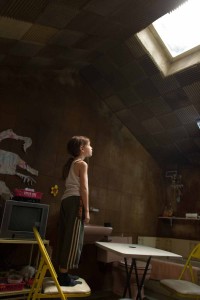
Tobman believes that restrictions, like the confined single room set in the first third of the film, push him to be more creative in producing something exceptional, especially if he has the right team. Without such challenges, designs can be “less inspired and less ingenious.”
“My way of approaching it was that we were building a solar system. The planets were revolving around Jack. Bathtub, wardrobe, bed, those are all different worlds. Every square inch of this space was imbued with so much history, and life and traffic,” explained Tobman. “Everyone envisioned this as a world that was enormously large and with a tremendous responsibility to capture.”
 Roughly 70 crew members also needed access to the small space to hit very precise technical targets, but that was not the only obstacle. The production was faced with capturing the very emotional material between the mother and son that comprises most of the beginning of the film in the limited time the child was allowed to work on set each day. Tobman came up with an inventive solution.
Roughly 70 crew members also needed access to the small space to hit very precise technical targets, but that was not the only obstacle. The production was faced with capturing the very emotional material between the mother and son that comprises most of the beginning of the film in the limited time the child was allowed to work on set each day. Tobman came up with an inventive solution.
“From the very beginning I had a dream of approaching this as an inverted Rubik’s cube where we built the entire set modularly, which played well into the idea that old Nick (Sean Bridgers) would have had a limited budget, a limited education, and would be using acoustic tiles and cork tiles, which are by far the cheapest way to sound proof a space, and come in one foot by one foot panels,” Tobman explained.
Instead of the traditional three-wall set, those tiles were employed to gain access to the room, while still retaining an intimacy that was beneficial for the performances.
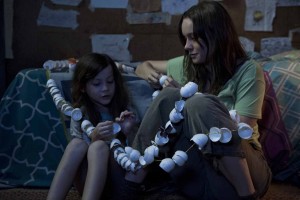 Probably more than any prior films, Tobman noted that he worked in tandem with cinematographer Danny Cohen. A skylight was the one source of sunlight in the room and there were only two practical lighting sources. The production designer did a lot of renderings on sunlight trajectories. The team experimented for a couple of weeks using Tobman’s computer models to see how the sun would traverse the room, taking into account the state, the month, the location, and the time of day. Through these tests they learned which wall tiles would be bleached from the sun.
Probably more than any prior films, Tobman noted that he worked in tandem with cinematographer Danny Cohen. A skylight was the one source of sunlight in the room and there were only two practical lighting sources. The production designer did a lot of renderings on sunlight trajectories. The team experimented for a couple of weeks using Tobman’s computer models to see how the sun would traverse the room, taking into account the state, the month, the location, and the time of day. Through these tests they learned which wall tiles would be bleached from the sun.
“It logically created a world as to how the details and the grain, and the flower that is Jack’s existence in room would grow,” shared Tobman. “Certainly what I always strive for, and what takes the most amount of time as a production designer and as a filmmaker, is trying to communicate truth without hitting people over the head with your intentions. It’s gotta just breath.”
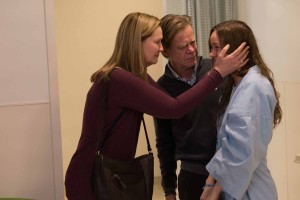 The design started with an extensive research process where Tobman approached captivity as an abstract concept, which led him to some of the smallest apartments in the world located in Asia, to the Holocaust and some of the most extensive prisons built, to solidary confinement in American prisons. In each of those, “there are truths to how walls are scratched, dirtied, cleaned and what personal objects people employ to survive.”
The design started with an extensive research process where Tobman approached captivity as an abstract concept, which led him to some of the smallest apartments in the world located in Asia, to the Holocaust and some of the most extensive prisons built, to solidary confinement in American prisons. In each of those, “there are truths to how walls are scratched, dirtied, cleaned and what personal objects people employ to survive.”
From the room, the action shifts to the completely white and sterile environment of the hospital, and then moves onto the mundane existence of middle-class living, including Ma’s bedroom that has been maintained exactly as it looked when she was abducted as a teen.
“People tend to hone into room because it is the most harrowing source of design, but I think the hardest thing in this job for me as a designer was to communicate the world outside of room,” stated Tobman. “That’s much less clear on the page. What we need to communicate is the exact opposite concept that you approach this movie thinking. You think once they are out of room, they’re free. In reality the true captivity of the experience arrives upon their liberation. How do you communicate that?”
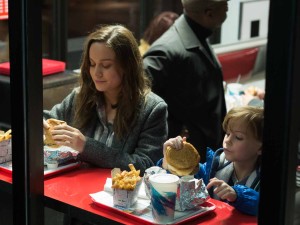 Tobman was immediately drawn to the idea that room would be approached inversely per palette. It would be warm, textured and full of life, history and personality. “It would be safe to Jack,” said Tobman.
Tobman was immediately drawn to the idea that room would be approached inversely per palette. It would be warm, textured and full of life, history and personality. “It would be safe to Jack,” said Tobman.
The world outside would be impersonal, cold, monotonous and without life. In the hospital it was very important for the filmmakers to establish an antiseptic, robotic and enormously scary environment to a boy “who had a relationship with a wall socket.”
Very conscious choices were made outside of the hospital to provide a suburban home that attempts to provide warmth and largely fails. Nuggets of plot, such as the fact that the Ma’s father (Bill Macy) has moved out since his daughter disappeared, were used to justify a degree of emptiness. Ma’s parents are a fragmented couple and half of their lives have been literally erased from the walls.
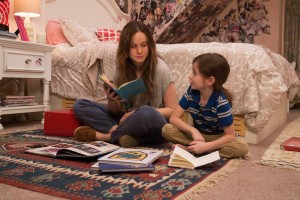 The wallpaper, the carpet, and the bedroom that was built, also reflected some of the choices in room. There is a wardrobe with louvered doors in Ma’s bedroom where Jack retreats to play that parallels the louvered wardrobe in room that is Jack’s safe place. In room Ma created a tree collage of drawings of Jack since she had no camera to capture his childhood. When her childhood bedroom is revealed, the wall sports a collage of her friends, models and actors. These design choices visually support both character and story.
The wallpaper, the carpet, and the bedroom that was built, also reflected some of the choices in room. There is a wardrobe with louvered doors in Ma’s bedroom where Jack retreats to play that parallels the louvered wardrobe in room that is Jack’s safe place. In room Ma created a tree collage of drawings of Jack since she had no camera to capture his childhood. When her childhood bedroom is revealed, the wall sports a collage of her friends, models and actors. These design choices visually support both character and story.
“If you’re 16 or 17 years old and you are arrested from your life, there are certain subtle things that I have to believe, not just as a designer but as a human being, I have to believe you’ll repeat previous behavior in your life, in where you occupy, and that you might use them to provide safety. Now what’s interesting is to then invert it and design a set where Ma might wake up in the middle of the night and see that wardrobe and question whether or not she’s still in room. I think that’s really important, both for our characters and for our audience to understand they haven’t really left room yet. Getting out of that space doesn’t mean they’re free.”
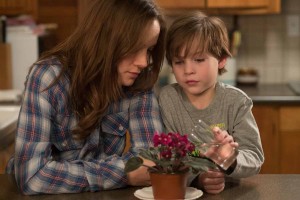 Although it was not a conscious choice on how he designed Room, the choices he made for Ma’s bedroom were validated by an experience Tobman had in college when he visited a female friend who was homesick. The decorating in the girl’s dorm room mimicked her bedroom back home. As a filmmaker, it was a life experience and inspirational clue that he collected that could be employed to bring truth to his designing. According to Tobman, every life experience should be tapped when dimensionalizing a fictional world.
Although it was not a conscious choice on how he designed Room, the choices he made for Ma’s bedroom were validated by an experience Tobman had in college when he visited a female friend who was homesick. The decorating in the girl’s dorm room mimicked her bedroom back home. As a filmmaker, it was a life experience and inspirational clue that he collected that could be employed to bring truth to his designing. According to Tobman, every life experience should be tapped when dimensionalizing a fictional world.
“I feel that as a designer you can do extraordinary work, but if you don’t have a story that moves you and characters that embody it, you’re ultimately failing at what you do,” said Tobman. “The responsibility I felt to capture these characters’ very real plight and the responsibility I felt to people who have either suffered from or suffered near victims of this story was among the most profound I ever felt. Without Lenny, Danny, Nathan [Nugent, editor]… without that synergy, I don’t think any of this would have been possible. That’s ultimately the greatest box we had to contend with and think outside of. That was the inspiration.”





